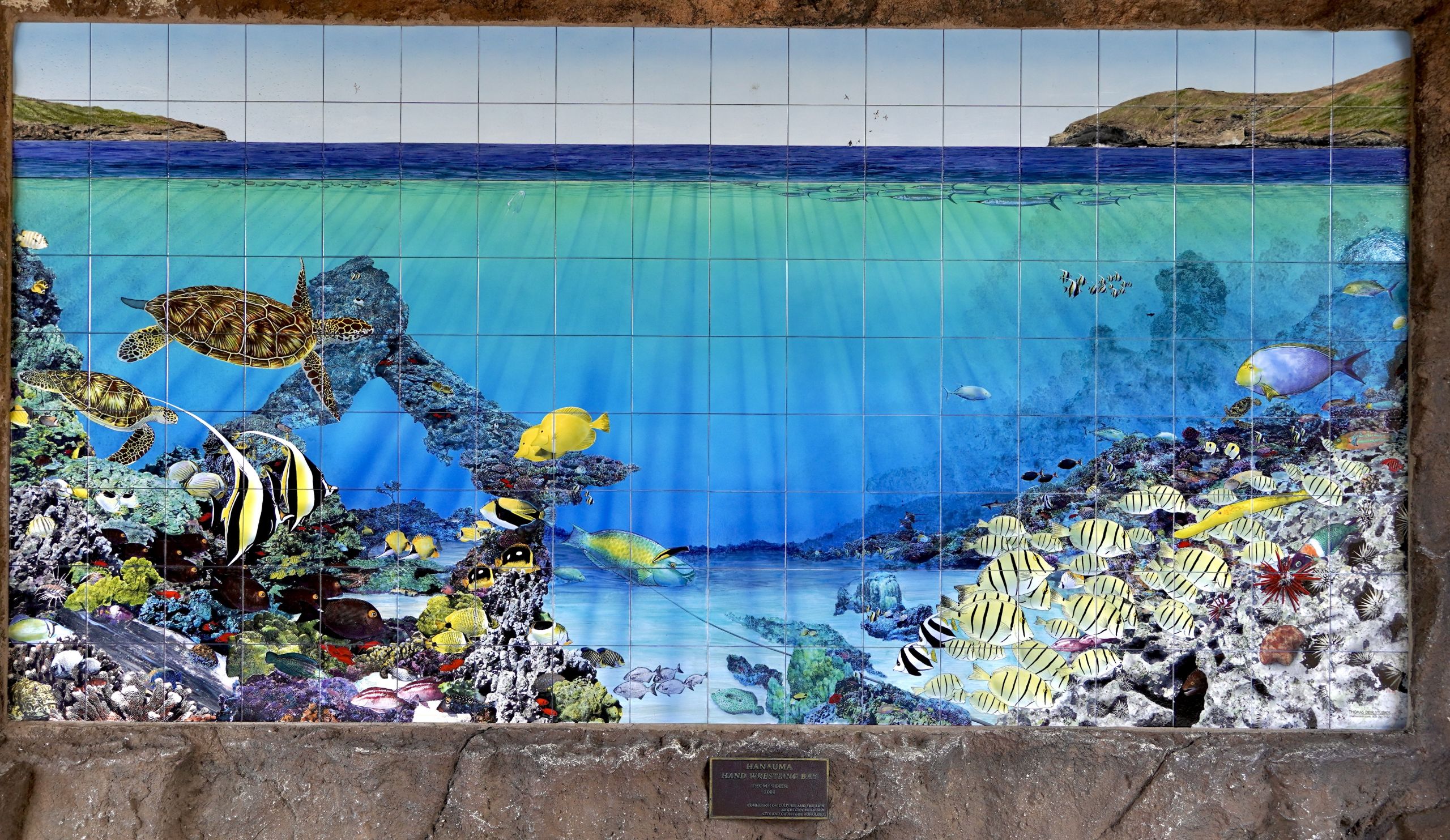
Manini - Convict Tang
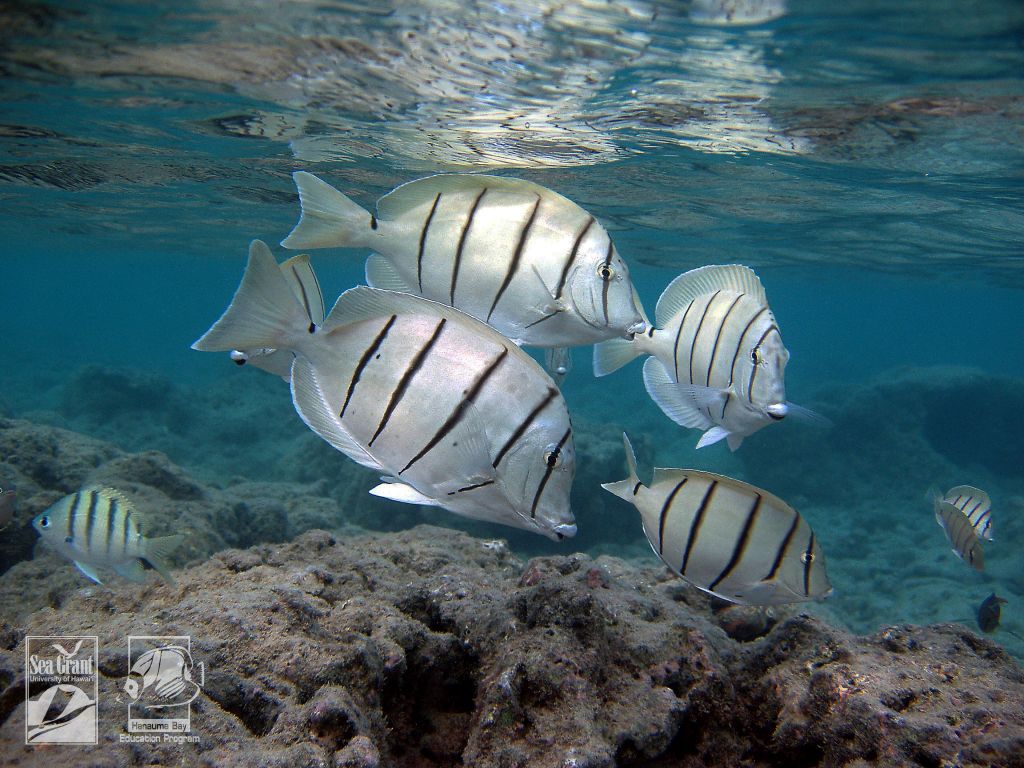
Manini - Convict Tang
Acanthurus triostegus
Convict Tangs are commonly seen throughout the Indo-Pacific region and are native to Hawai‘i. They feed on algae off of reef flats and tend to travel in large schools. Their distinctive stripes also help to discourage predators from attacking them by breaking up their silhouette. Their role on the reef as algae eaters helps keep algae from overgrowing and smothering the reef.
Their common name, the convict tang, refers to their vertical bars as reminiscent of prison bars. In Hawaiian, these fish were an important and abundant source of food and had many names for their various life stages. Throughout their life their names change based on their size and behavior starting with ʻōhualiko, ōhua kāniʻo, palapōhaku, kākala manini, maninini, and finally Manini as adults.
‘Ōlelo No‘eau:
Ka i‘a a ke kualau i lawe mai ai.
The fish brought in by the rain at sea.
The spawn of the manini fish that came to the islands by the millions during the summer months. They were said to come after a shower at sea, in the early morning.
Uhu
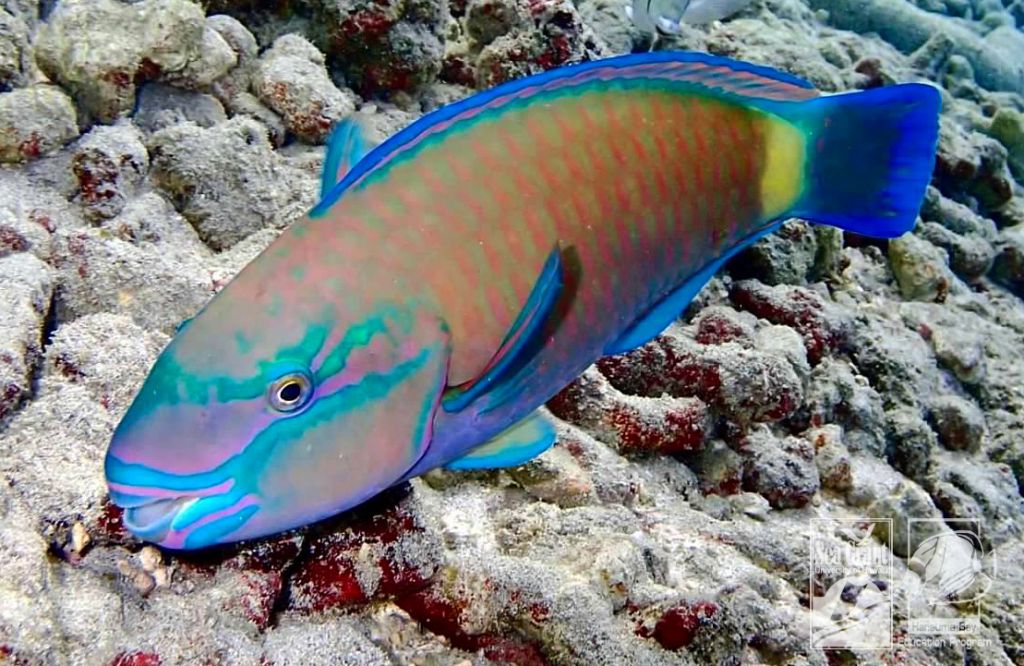
Uhu - Parrotfish
(Scaridae)
Parrotfish are a group of fish found throughout the Indo-Pacific region. Many species are native to Hawaii with a few that are endemic; found nowhere else in the world. These large animals come in a variety of colors and sizes, but their most prominent feature are their strong beak-like teeth which they use to graze on coral reefs. As they scrape algae off of the reef they also ingest and process the coral in their bodies. The end result is ground up grains of sand that the fish releases into the water. The Hawaiian name "uhu pālukaluka" means "loose bowels".
While common on many reefs, the parrotfish found in Hanauma Bay are some of the largest that can be seen in Hawaiʻi. Outside of Hanauma Bay's protections, parrotfish are regularly caught for food. The removal of large herbivores off of reefs has proven to be very harmful to Hawaiʻi's marine environments like Kāneʻohe bay. Without these herbivores, algae can spread widely and suffocate corals. These same corals provide food and shelter for other fish, which creates a cycle of loss.
The Hawaiʻi Institute of Marine Biology has worked hard to manage algal blooms through the introduction of native urchins to continually graze on algae, but overfishing still poses a threat to other reef ecosystems. We can continue to improve our reef ecosystems by taking a few simple actions. Remembering to shop for sustainably harvested fish helps to discourage overfishing. When fishing, remember to observe size regulations and to take only what you need.
To Learn more visit:
NOAA - Get to Know Your Seafood
Kihikihi
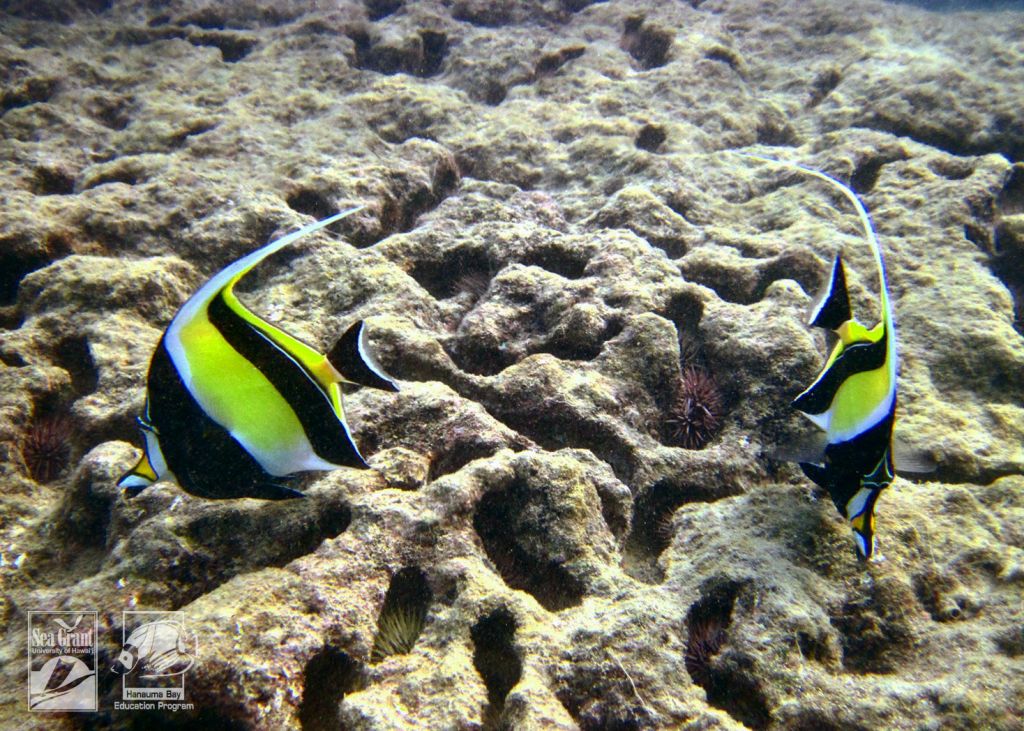
Kihikihi - Moorish Idol
Zanclus cornutus
Moorish Idols are native to Hawaii and found globally in shallow reef environments where they feed on sponges, corals, and other invertebrates. They are commonly seen along the reef alone, though it is not uncommon to see them in pairs or groups. Moorish Idols are one of the most recognizable fishes with their triangular bodies, banded coloration, and long white dorsal fin.
The presence of fish like Moorish idols is a good indicator of reef health. Moorish idols are notoriously picky about their foods in captivity and rely on healthy reef environments to maintain a healthy diet. When reefs have a wide variety of fishes living on them, like at Hanauma bay, that tells us that the reef is alive and thriving.
To help us understand more about fish abundance and diversity, several organizations work to map this information across different parts of the world. Knowing what fish are commonly found in different parts of the reef helps to paint a better picture of what a healthy reef can look like.
To learn more about:
Fish counts start here
Lauʻīpala
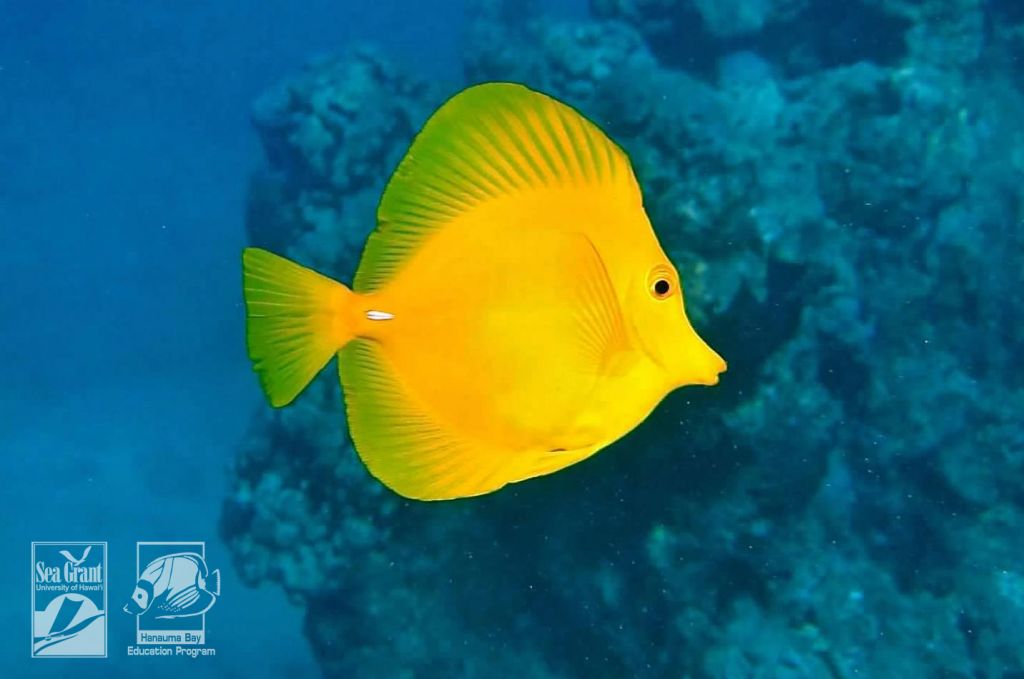
Lauʻīpala - Yellow Tang
Zebrasoma flavescens
Commonly found throughout the Pacific in shallow waters including Hawaiʻi, the Yellow Tang is a beautiful fish that, with the exception of their white tail spine, are entirely yellow. Their Hawaiian names make reference to this, meaning “Yellowed Leaf”. As juveniles these fish are territorial, but calm down as they mature.
The Yellow Tang’s distinct appearance makes them prized fish in the aquarium industry. About 98% of all saltwater fish in aquariums are caught in the wild rather than being bred. However, the removal of fish like Yellow Tangs from the reef, whether for aquariums or food, can harm the natural environment and the fish themselves. Yellow Tangs’ distinct mouth shape and diet make them hard to breed and raise. Equally, fish are needed to maintain the balance between algae and reef growth. Without them one can overtake the other and lead to more fish starving and dying.
That’s not to say that having an aquarium can’t be fun and helpful. Efforts like those at HPU’s Oceanic Institute are working towards breeding and raising saltwater fish for aquarium trade. Always be aware of where your fish come from and how to properly care for them.
Learn more about:
Yellow Tang breeding at HPU’s Oceanic Institute
Island of O'ahu
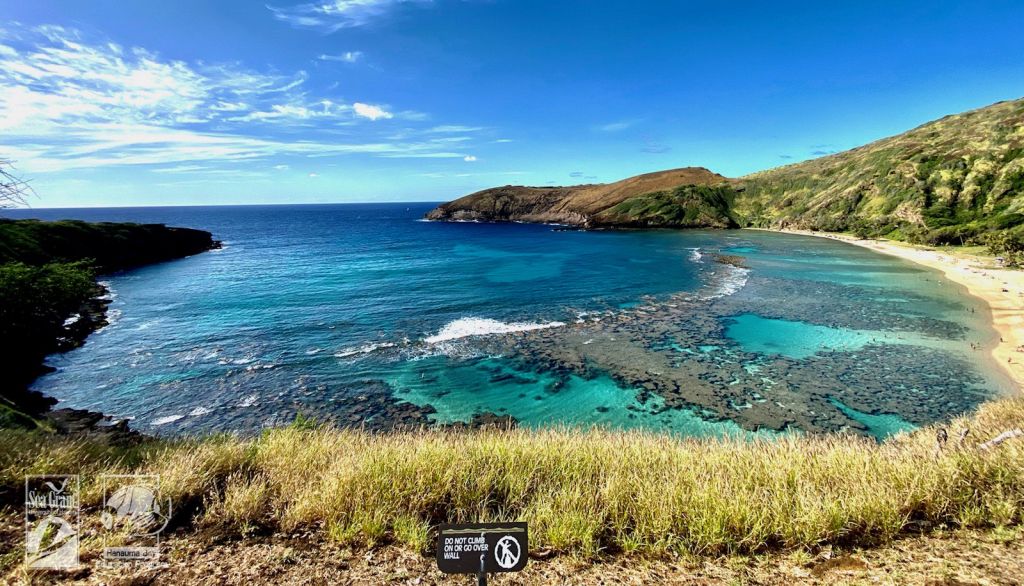
Hidden amongst the corals and reef is a strange coral head with much to say. One translation of the name "Hanauma" is "Arm Wrestling Bay", and is visualized by this distinctive, though fictional, coral head representation of an arm wrestling match. Within this coral head is the silhouette of the island of O'ahu, with Hanauma Bay highlighted by the nearby Humuhumunukunukuapua'a.
The nearshore waters of Hawaiʻi have been foundational to the lives of its people and is home to some of our most treasured resources. They play host to hundreds of colorful species of fishes and invertebrates; some of which are found nowhere else in the world. They provide food and recreation to their communities and visitors alike. In order to maintain and preserve these valuable resources the state of Hawaii creates Marine Life Conservation Districts (MLCD) like Hanauma Bay. MLCDs provide protected areas where fish and other marine life can thrive and reproduce so that they may be enjoyed by generations to come. On the island of Oʻahu we have three MLCDs: Hanauma, Pūpūkea, and Waikīkī.
You can learn more about:
Marine Life Conservation Districts here.
Place names around Hanauma Bay here.
Honu
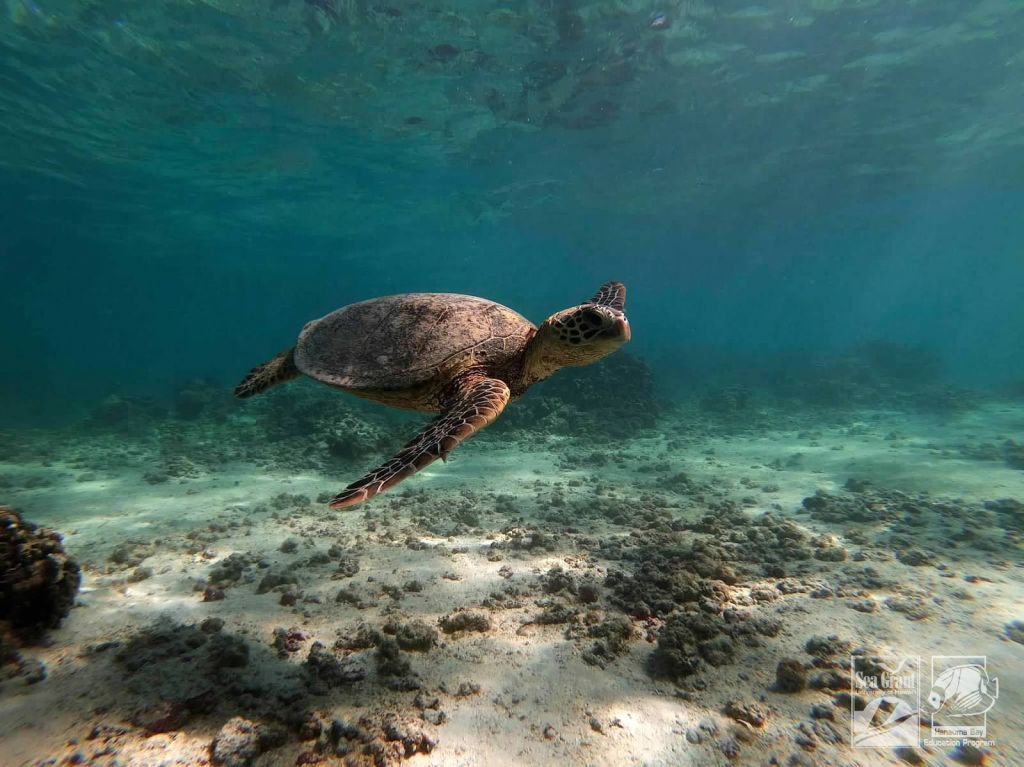
Honu - Green Sea Turtle
Chelonia mydas
Green sea turtles are found globally in tropical and subtropical climates and are native to Hawaii. Green turtles get their names, not from the color of their skin or shells, but rather the color of their fat, which turns green due to the algae that they eat. Turtles can live well over 70 years in the wild, but do not reach maturity until the ages of 25-35. Green sea turtles spend a majority of their lives at sea, however in Hawai’i they occasionally pull up onto beaches to warm themselves; a behavior uncommon in other green sea turtle populations.
Globally, green sea turtles are listed as an endangered species, meaning they face the threat of extinction in the near future. Turtles face many threats such as loss of breeding grounds, hunting by humans, as well as pollution like ghost nets and marine debris. Turtles will often mistake plastics as food and ingest them, which can lead to starvation or choking. Turtles can also get tangled in stray nets and fishing lines. Due to these threats coupled with their slow reproductive cycle, these turtles are slowly declining in population.
While many populations of sea turtles are declining, the Hawaiian population of green sea turtles has risen greatly over the past few decades. This is thanks to heavy conservation efforts made to protect these animals as well as efforts made by the public. Simple actions such as participating in beach clean-ups can help by removing plastics, nets, and fishing line off of beaches before they wash out to sea.
To learn more you can visit:
If you see a turtle in trouble you can call:
NOAA Hotline (888) 256-9840
Koʻa
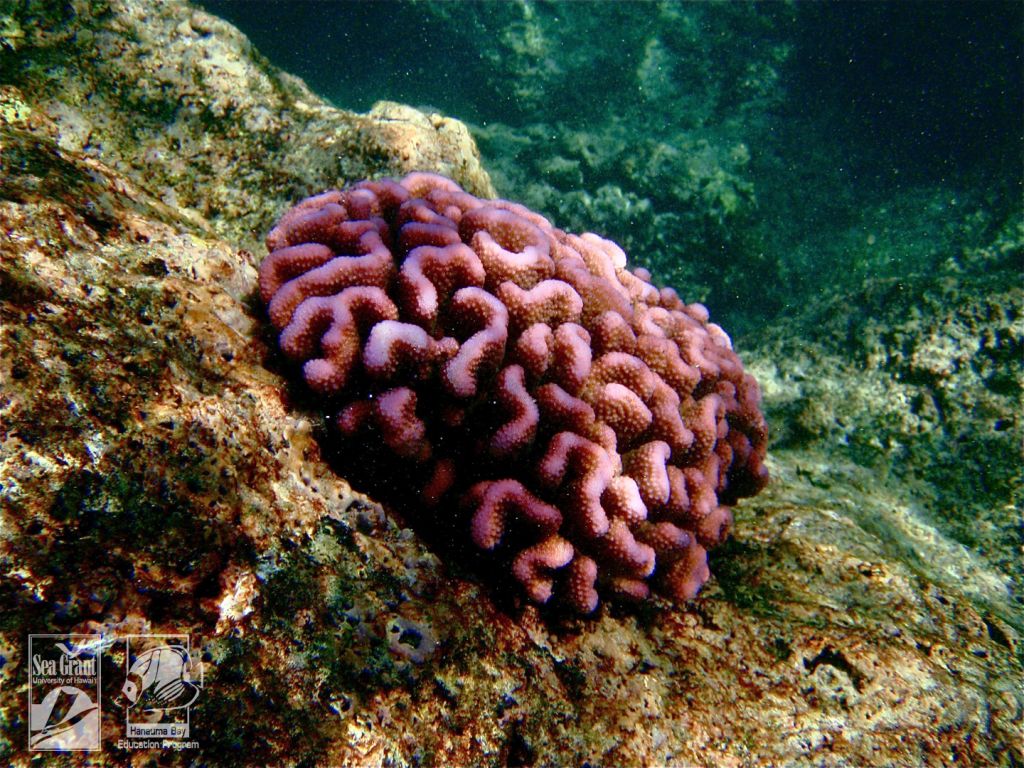
Koʻa - Corals
Corals are found around the world in tropical and subtropical climates. While they may look like rocks, these are actually animals that form large stone-like structures in many shapes, sizes, and colors that we call reefs. Corals serve as both food and shelter to a wide variety of marine life and are the foundations of near shore ecosystems. Corals grow very slowly, less than one inch per year, and can live to be hundreds, even thousands of years old. Corals thrive off of an algae called zooxanthellae that grows inside its own body, as well as by collecting floating nutrients in the water. These zooxanthellae are what give each coral species its distinctive coloration.
Corals are threatened around the world due to pollution and rising ocean temperatures. When ocean waters become too hot corals will "bleach", the act of expelling their symbiotic algae from their bodies, which exposes the bare white skeleton beneath. An easy indicator of coral health is color. Dying and dead reefs are often colorless. Without this algae they lose their main source of nutrient and can die. Equally pollutants and harmful chemicals can stunt growth and harm coral reefs.
There are a few simple acts we can take to protect reefs from bleaching. One thing everyone can do is to use reef-safe sunscreens. Some sunscreens use harmful chemicals such as oxybenzone and avobenzone, which are harmful to both humans and marine life. Switching to mineral based sun protection, or full body coverings while in the ocean can greatly reduce the presence of these chemicals on reef ecosystems around the world. Equally, reducing our carbon footprint (the amount of CO2 we produce when using electricity or gas), helps to slow global climate change. Simple things like walking, biking, carpooling, and taking public transit all help to reduce our carbon footprints.
To learn more about visit:
ʻAha
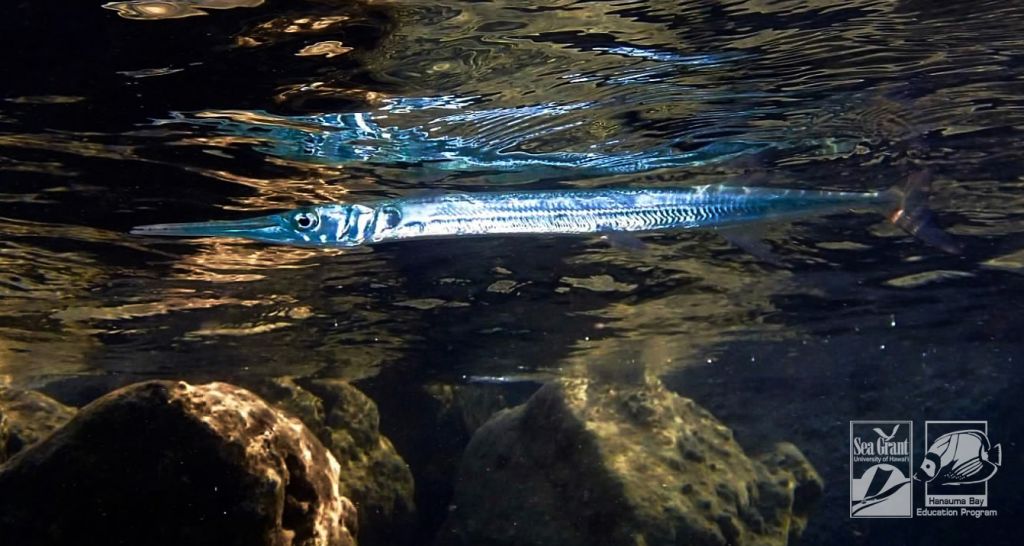
ʻAha - Keeltail Needlefish
Platybelone argalus
Commonly found natively in Hawaii and around the world in shallow waters, the Keeltail Needlefish can be found just below the water’s surface in large schools. They are often seen resting during the day and feeding at night. Their narrow mouths are filled with sharp teeth, which they use to capture prey and swallow them whole. However, small prey animals are not the only things found floating at the surface of the ocean.
Plastics that make their way into the ocean can float for long periods of time, slowly breaking down into smaller and smaller pieces called microplastics. Many fish can mistake these small fragments for food. Once eaten these plastics will fill an animal's stomach. With stomachs full of plastic and unable to eat real food, these fish can quickly starve. If they don’t starve first, many of these fish become prey for larger fish like ulua (trevally) and ʻahi (tuna). Those plastics stay in the bigger fish and pass on plastics to the next animal that eats them. This process of passing harmful chemicals and plastics from one animal to another up the food chain is called biomagnification. These plastics can eventually make it into the fish that we eat.
However, there are a number of ways we can prevent plastics from reaching our dinner plates. Remembering to reduce plastic use wherever possible, and recycling what can be are great ways to keep plastic out of landfills and the ocean. While many organizations provide large beach clean ups, anyone can pick up a bag and sift through the plastics they find on the beach. Every piece taken off the beach is a piece that won’t reach the ocean.
For more information:
Research a beach cleanup that fits your schedule or go on your own!
Hanauma Bay Interactive Reef
This stunning mural sits at the entrance to Hanauma Bay's Visitor Center and details the colorful collection of marine life found there. Explore and learn more about our wildlife by clicking on them in the mural.
Hanauma Bay Education Program, Hawaiʻi Sea Grant
HANAUMA, HAND WRESTLING BAY mural by Thomas Deir, 2001
Commission on Culture and The Arts, Art in City Buildings, City and County of Honolulu
Humuhumunukunukuāpua'a - Reef Triggerfish
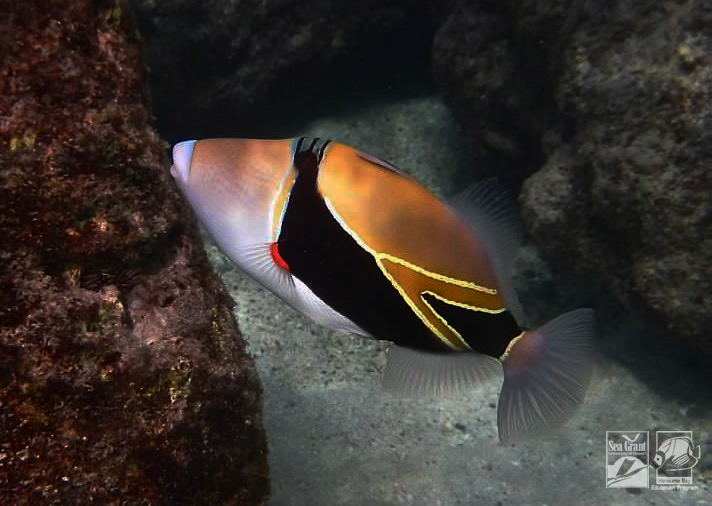
Humuhumunukunukuāpua'a - Reef Triggerfish
Rhinecanthus rectangulus
The Triggerfish is one of the most common carnivorous reef fishes of Hawaii. The Waikiki elementary school chose the Reef Triggerfish (Humu) as the state fish of the Hawaiian Islands in 1984. Their Hawaiian name means “fish with a snout like a pig.”
Their unusual physical features are easily noticeable. The small eyes of the fish are located further away from their mouth. This helps them eat the algae off the sea urchins and other invertebrates without getting poked in the eye. There are two dorsal fins placed forward on the body above and behind the eyes. Triggerfish have tough skins and small but strong mouths. Their independently movable eyes are positioned high and about one third of the way down the body. The position of the eyes allows them to eat long spined sea urchins.
Triggerfish lay and fertilize their eggs on the bottom sea floor and guard them until they hatch. Although normally wary and shy, they can defend their nests aggressively, charging and even biting those who come close. During nesting season they are not afraid to chase you away from their eggs.
Moa - Spotted Boxfish
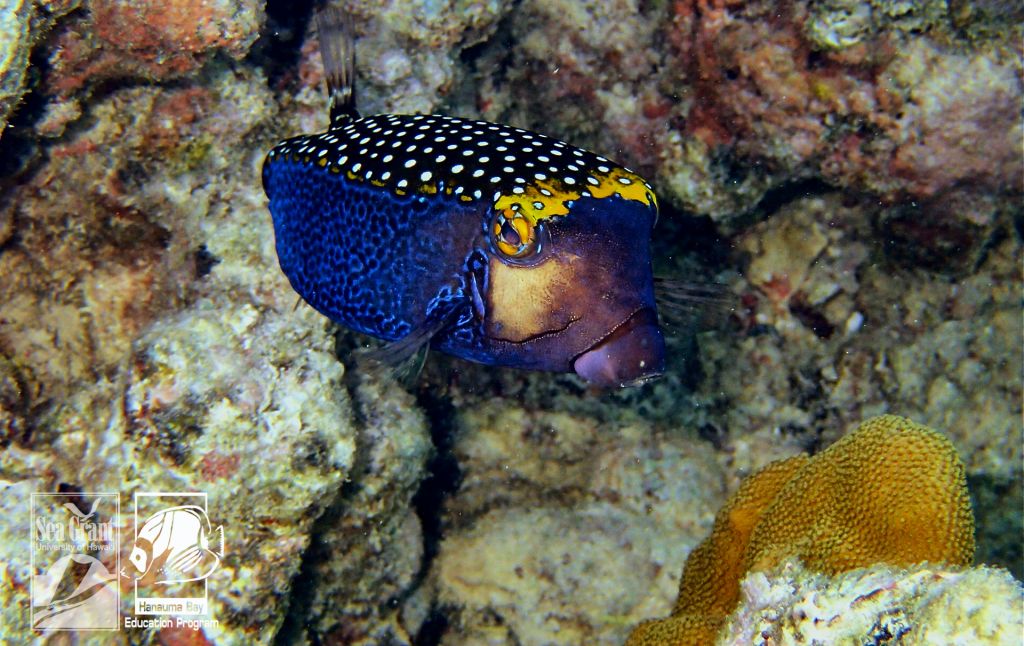
Moa - Spotted Boxfish
Ostracion meleagri
Boxfish are protected by an armored plate that covers their whole bodies. Only their eyes, fins and mouths are movable. When threatened, most boxfish can secrete a toxic slime from their skin. This toxin can kill other fish if the boxfish is kept in the same aquarium, but it is not known to affect humans. Males are often more colorful than females. There are five different species of boxfish found in Hawaiian waters, but only three of those species are likely to be seen by the average snorkeler: the Thornback Cowfish, the Spotted Boxfish, and the Whitley Boxfish. Boxfish have been known to forage on sponges, algae, tunicates, worms and small crustaceans.
Pāki’i - Flounder
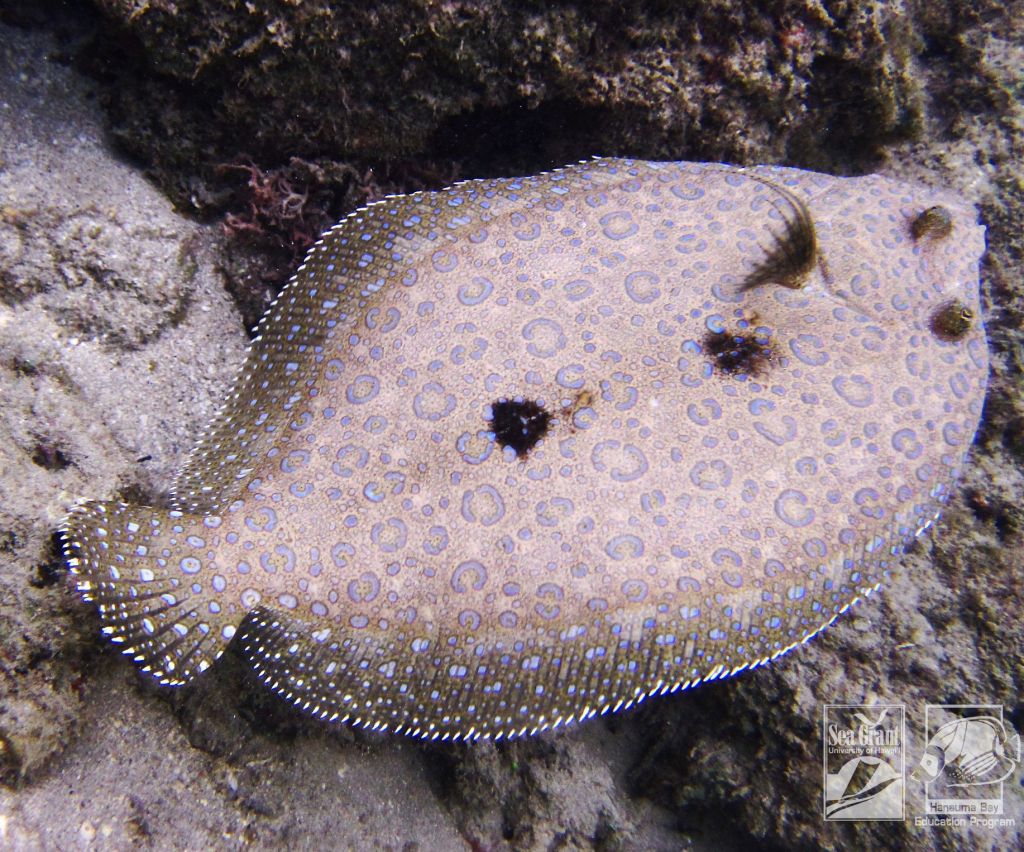
Pāki’i - Flounder
Bothidae
These fish are found on the sand or gravel seabed. They are extremely well camouflaged, nearly invisible to both prey and predator because their coloration blends them into their environment, and their bodies are flat against the bottom. They eat small crustaceans and other smaller fish. Flatfish are born like any other fish, with eyes on either side of their heads, but as they grow, one eye moves to join the other eye, and their bodies lean until they are flat against the seafloor.
Winged Box Jellyfish
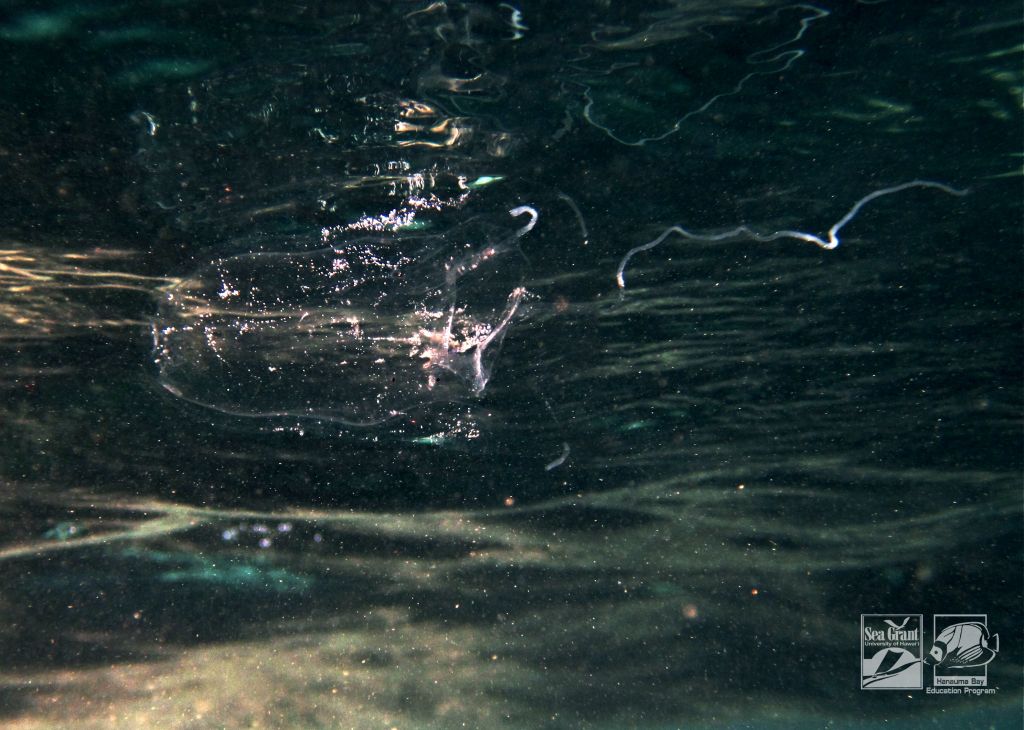
Winged Box Jellyfish
Carybdea alata
Colorless and transparent, these jellyfish have a three-inch long, two-inch wide bell. They have four opaque, pale pink, white or clear tentacles. They are strong swimmers. These jellyfish are difficult to see, and often look like clear plastic floating in the water. Each month, seven to ten days after the full moon, these animals may appear along the south-facing shores of Oʻahu. They can wash ashore in the hundreds or even thousands in a single night. The sting of a box jellyfish affects people differently. Some people may have a violent reaction and may need emergency medical treatment.
ʻōmilu - Bluefin Trevally
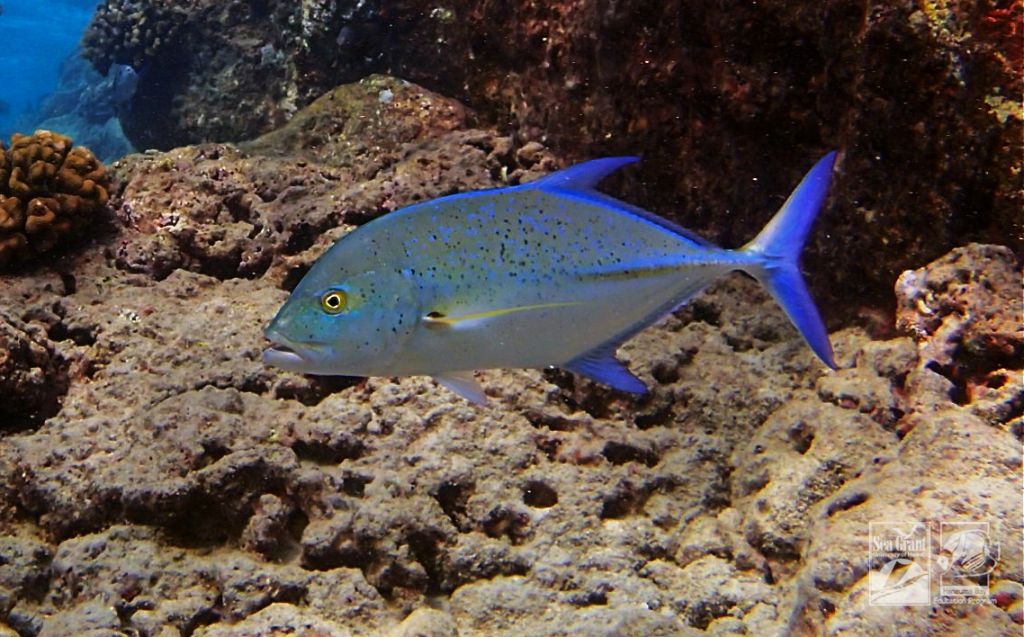
ʻōmilu - Bluefin Trevally
Caranx melampygus
The bluefin trevally is silvery blue, speckled with blue dots, and has vibrant blue fins. They can change their coloring quickly and can sometimes appear almost black. They are seen swimming alone, or in pairs, and sometimes in groups. They normally inhabit shallow reefs. These fish are predators, and sometimes hunt with a companion. Most often the companion hunters are octopus, eels, goatfish and rays. The companion hunter scares prey out of holes or out of the sand, making prey easier to catch.
Pualu- The Yellowfin Surgeonfish
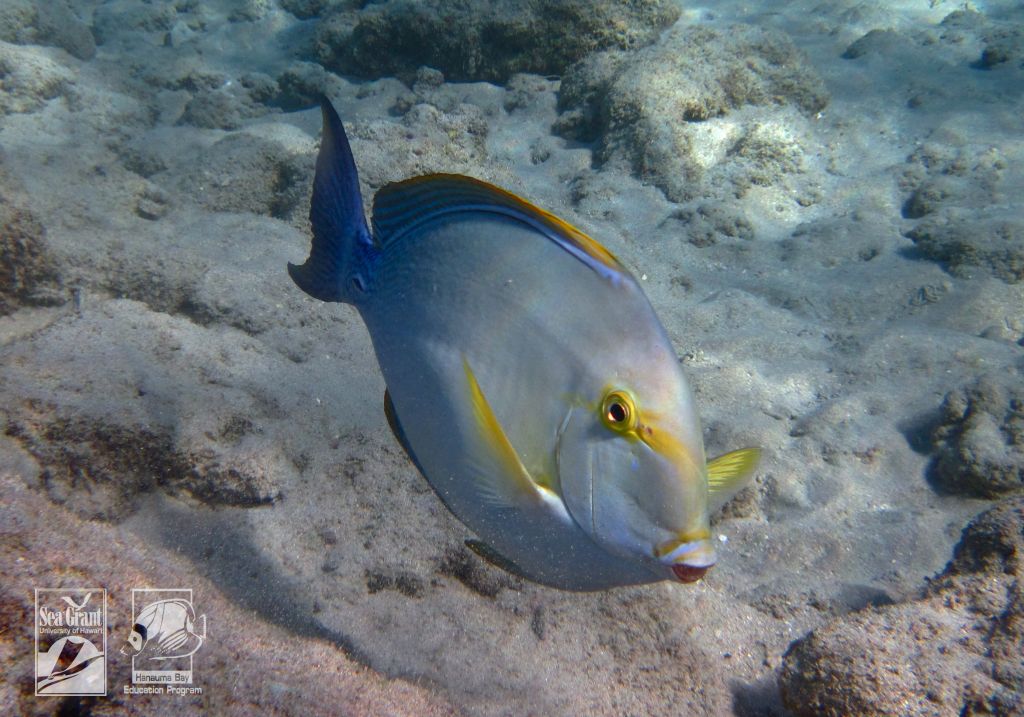
Pualu- The Yellowfin Surgeonfish
Acanthurus xanthopterus
Surgeonfish can be found in East Africa to the islands of the tropical eastern Pacific. They are the most abundant and prominent fishes on Hawaiian reefs. Surgeonfish get their name from the scalpel located on the middle of their caudal fin. This scalpel is used as a defense mechanism against predators. The names “surgeonfish” and “tang” are often used interchangeably.
Yellowfin Surgeonfish can be purplish gray, but can quickly put on an irregular yellowish linear pattern. They are herbivores and primarily feed on algae growing on compact sand. Usually they are found in schools but can be found alone. The Yellowfin is the largest of all surgeonfish.
Hā ʻuke ʻuke ʻula ʻula - Red Pencil Urchin
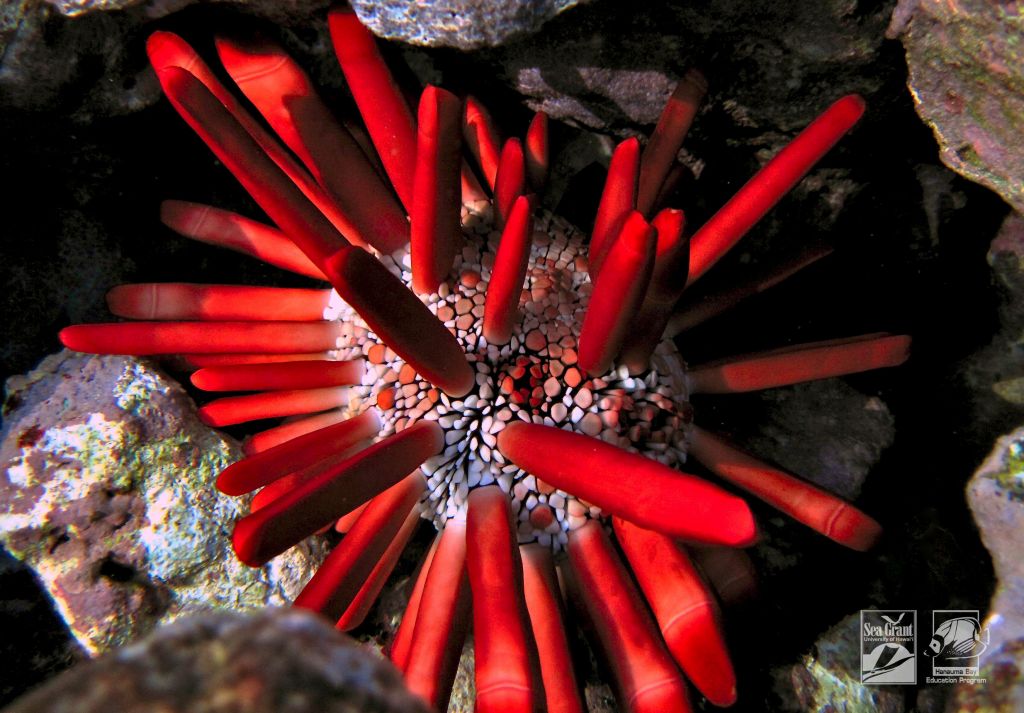
Hā ʻuke ʻuke ʻula ʻula - Red Pencil Urchin
Heterocentrotus mammillatus
These urchins are bright red with dull pointed spines. A thin layer of tissue covering the spines inhibits algae growth. Back when it was customary to use slates and chalk, these spines could be used in place of normal chalk, thus the alternative name: Slate Pencil Urchin. The Hawaiian name ʻula ʻula, means red.
Hīhīmanu - Spotted Eagle Ray
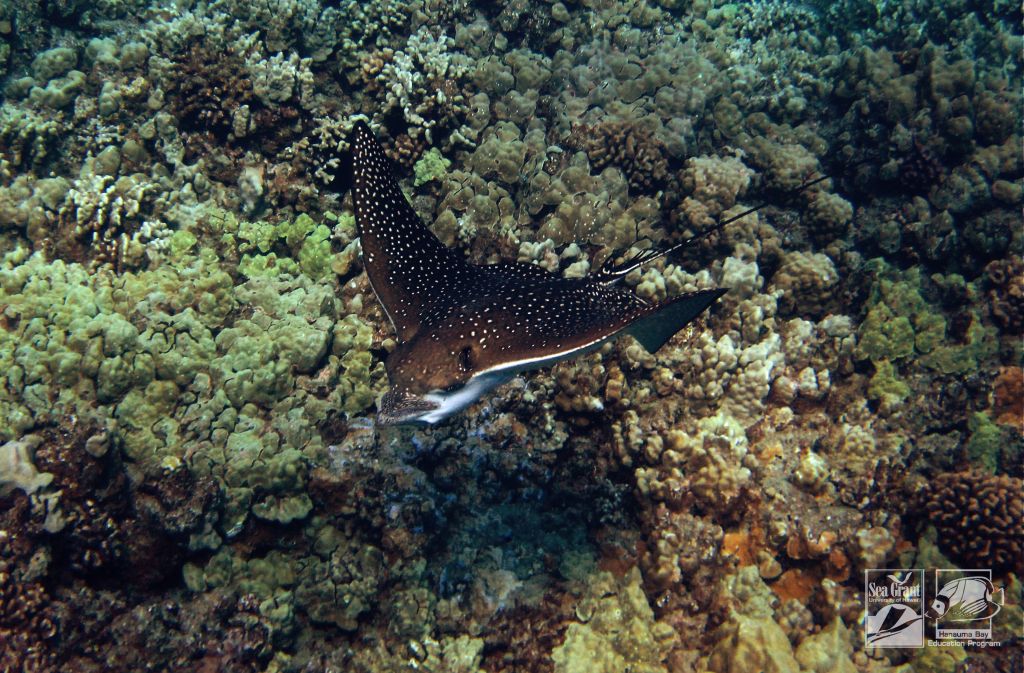
Hīhīmanu - Spotted Eagle Ray
Aetobatus ocellatus
Spotted Eagle Rays are black, gray, or brown with white spots on their back. They have white underbellies, and can have a wingspan of up to six feet. Their tails can be three times their body width. At the base of the tail, they can have between one to five venomous spines. Eagle rays occur in warm seas around the world. The Hawaiian word hīhīmanu, means “elegant”, “magnificent” or “lavish”. Eagle rays in Hawaiian waters rarely school, and are often seen swimming above the reef bottom.
Nūnū - Trumpetfish and Coronetfish
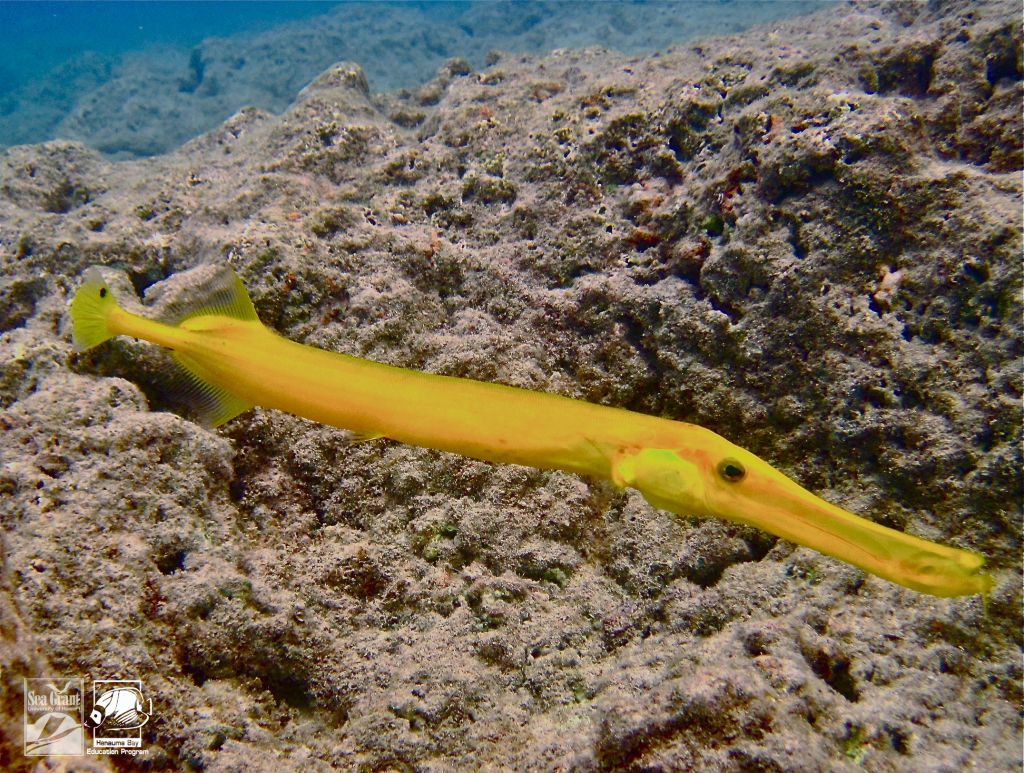
Nūnū - Trumpetfish and Coronetfish
Aulostomidae, Fistulariidae
Tumpetfish have stiff, elongated bodies. While coronet fish have flexing, elongated bodies. Both types of fish are piscivores, meaning they eat other fish. They are able to expand their mouths and suck in their prey. They are most active during the early morning and late afternoon. Their common names were given to them because their bodies are shaped like musical instruments.
Nenue - Gray Chub
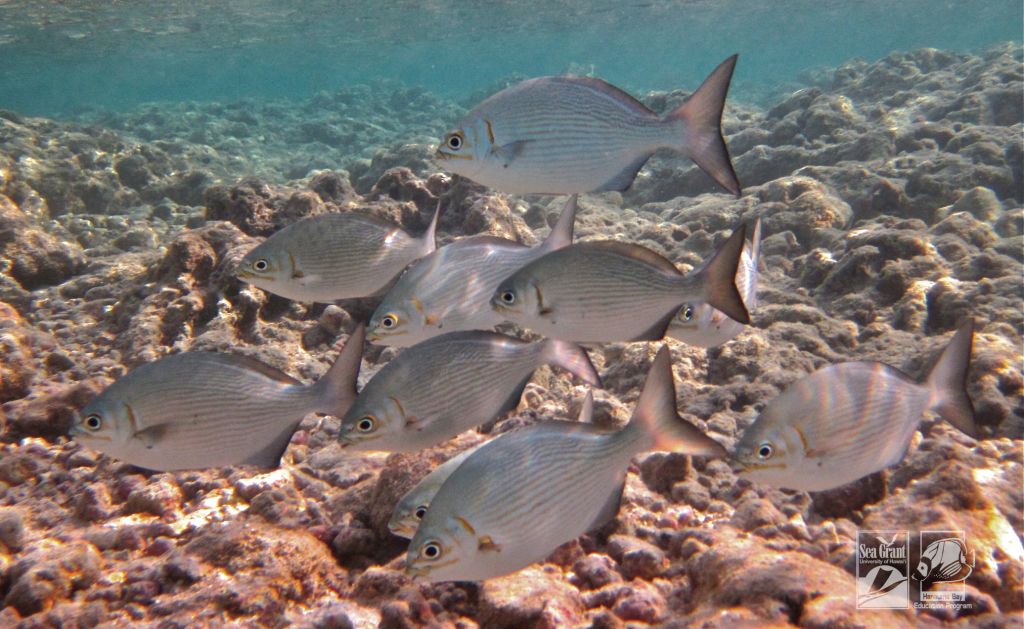
Nenue - Gray Chub
Kyphosus sandwicensis
The most common chub in Hawai’i is the Gray Chub. It is a blue-gray with a pale line along the curve of its back, but occasionally individuals can be yellow, white, or multicolored. They tend to school in shallow rocky areas, or along exposed rocky coasts. In old Hawai’i it was thought that the yellow chub was the “queen” of the school, however it has since been proved that there is no social significance associated with certain color variations.
Kole - Goldring Surgeonfish
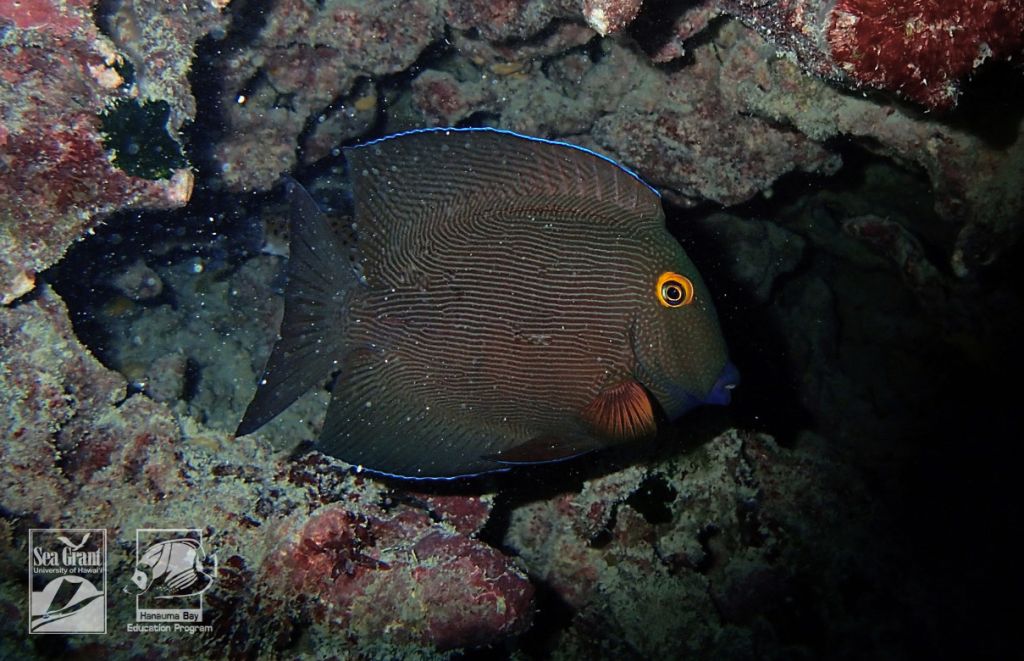
Kole - Goldring Surgeonfish
Ctenochaetus strigosus
The Goldring surgeonfish has a bright gold circle around its eye and a blue mouth. It has a dark body with thin horizontal lines, and some juveniles can even be completely yellow with no pattern or marks. Surgeonfish overall are oval or oblong, with compressed bodies and eyes set high on the head. Their scales are so small that they have a smooth appearance.
Goldring surgeonfish do not eat algae like many other surgeonfish. They actually survive off of organic detritus, or dead matter, that settles on the reef. A long time ago in Hawai‘i they were placed under the posts of a new house to bring good luck, and their Hawaiian names were even used often as a name for an attractive person because they were thought to be so beautiful. The Hawaiian name means “raw” since that is how they were often eaten, and they are now known to be endemic species to Hawai‘i, meaning it cannot be found anywhere else in the world.
Puhi ʻōni ʻo - Whitemouth Moray Eel
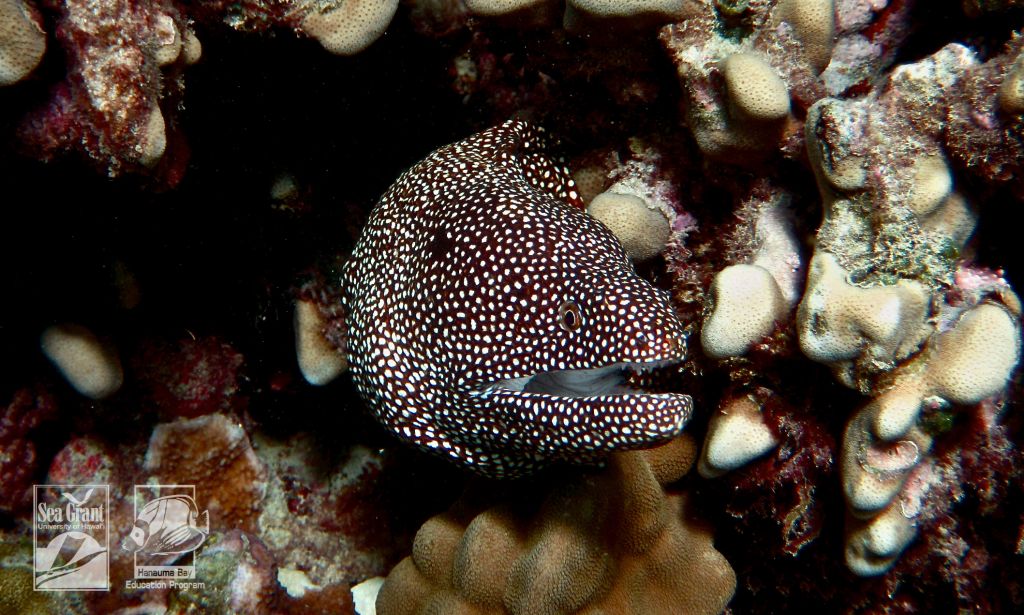
Puhi ʻōni ʻo - Whitemouth Moray Eel
Gymnothorax meleagris
This type of eel is commonly seen in Hawaiʻi. It is mostly brown with white dots. The interior of its mouth and the very tip of its tail are bright white. Moray eels are often seen hunting alongside trevally, groupers and goatfish. This eel often hunts with fish by entering a hole or crevice, where the fish block the exit ready to catch any escaping prey. Eels are adapted to live in crevices and holes, meaning they’re long snake-like bodies often have no fins or scales. They often are seen poking their heads out of holes in the reef with an open mouth and teeth showing. This behavior can seem intimidating, but the eels are only pumping water over their gills in order to breathe.
In old Hawaii some eels were considered a delicious food source and were even referred to as being “choicer than wives”. Other eels were known as ‘aumākua, which is a physical embodiment of certain family gods.
Cushion Star
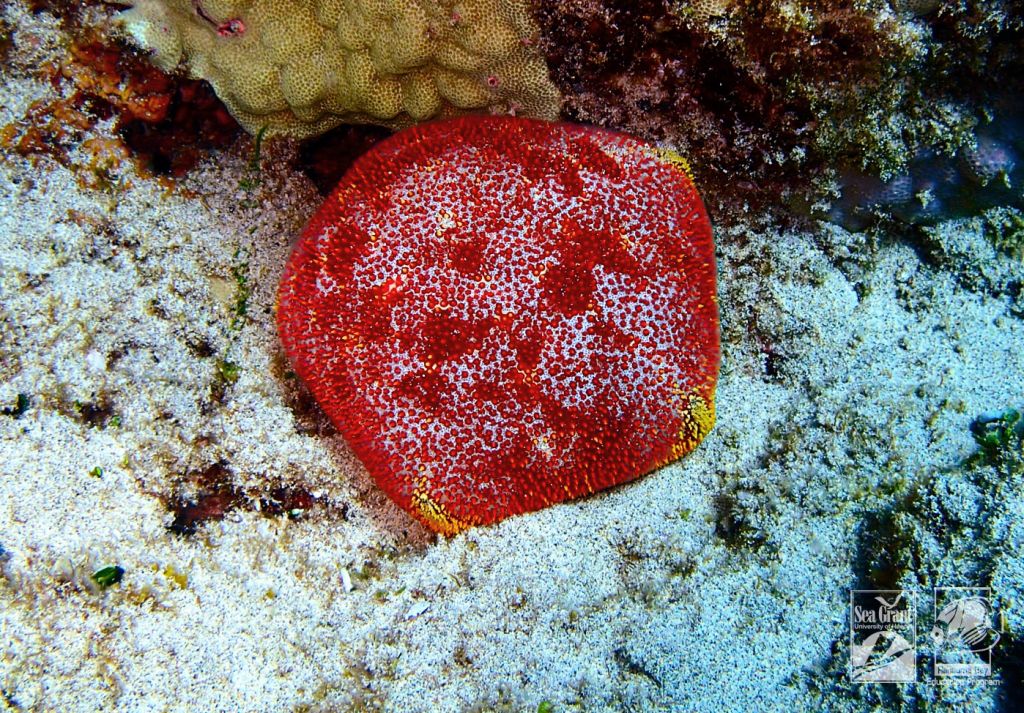
Cushion Star
Culcita novaeguineae
The Cushion Star gets its name from their plump five-pointed bodies. They can be red, maroon, tan or yellow. Small specimens are flat with five stubby arms. Adults do not have arms, but they have five colorful rows of tube feed that extend from the central mouth. The mouth is located on the underside of the cushion star. These creatures push out their stomachs to feed on live coral. They digest the coral polyps and often kill the coral completely. If a cushion star is turned upside down, it is able to flip itself back over. It does this by inflating one side of its body with water, arching over to get a grip with its tube feet, and pulling itself over. It also uses the same mechanism to mold its body into different holes and ledges on the reef.
Manō lālā kea - Whitetip Reef Shark
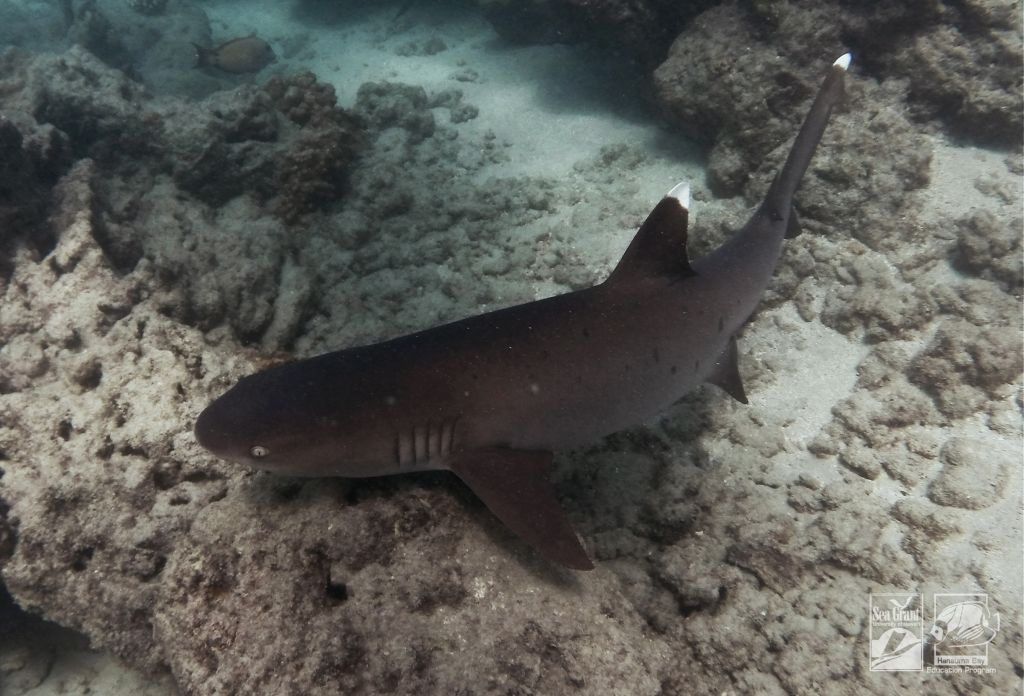
Manō lālā kea - Whitetip Reef Shark
Triaenodon obesus
The Whitetip Reef Shark is one of the most common sharks seen in Hanauma Bay and within Hawaii’s coral reef ecosystems. They have a broad snout with two small nasal flaps protruding under the snout, their body is grayish brown, and they have a primary and secondary dorsal fin sitting far back on the body with the top of each colored a bright white. They are often seen sleeping or resting under overhangs and in caves in the reef but can occasionally be seen swimming over the reef. Unlike other species of sharks, Whitetips do not have to swim in order to keep water running through their gills, they are able to open and close their mouths to push water out their gills and keep them alive. Their Hawaiian name means “white fins” and they are a very docile species of shark. They feed on small fish and crustaceans.
Leho Kiko - Tiger Cowry
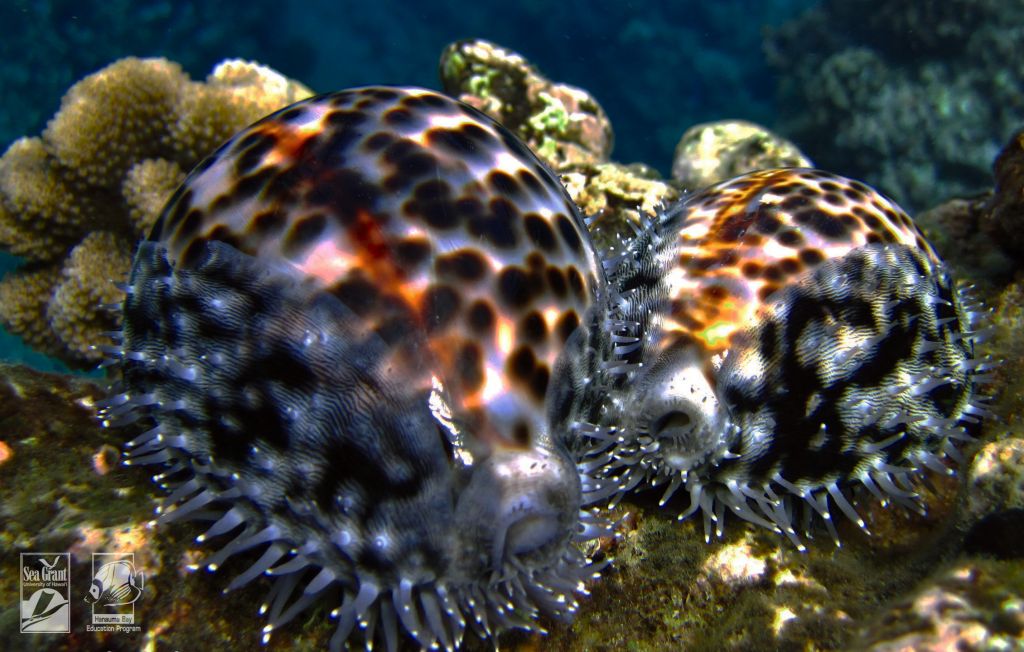
Leho Kiko - Tiger Cowry
Cypraea tigris
Tiger Cowries in Hawai’i are some of the largest in the world, however they were not officially recorded in Hawai’i until the 1930’s. The Tiger cowry is white with dark spots, however the number and size of the spots can create shells ranging from very light to almost solid black, and no two patterns are the same. The mantle of this cowry, the outer wall of the molluscs’ body, is dark gray with brown smears or spots and the papillae, the fleshy projections on the mantle, are pointed and white-tipped.
Nohu Pinao - Hawaiian Red Lionfish
Nohu Pinao - Hawaiian Red Lionfish
Pterois sphex
The Hawaiian Red Lionfish goes by many names. It is most often called the Hawaiian Turkeyfish, but can also be known as the Zebrafish, Fireworks-fish, Firefish, and Butterfly-cod. It is quite uncommon to see and it is closely related to various scorpionfish. It is striped red and white with unusually long dorsal spines and long white spines on the pectoral fins. There are a pair of antennas right over the eyes on most individuals, except some of the larger fish. In Hawaiian, Nohu Pinao means “dragonfly”, which it looks like with its pectoral fins extended, and the scientific species name means “wasp”, most likely from the venomous sting that can come from its spines.
Hīnālea lauwili - Saddle Wrasse

Hīnālea lauwili - Saddle Wrasse
Thalassoma duperrey
The saddle wrasse has a dark blue-green head with a thick dark orange band around its middle section, looking like a saddle, followed by a blue-green back end with small vertical magenta stripes. Terminal males, those ready to reproduce, have a slim white band after the thicker orange band, which they can brighten to attract a mate. The juvenile fish can occasionally act like cleaner wrasse, eating parasites and mucus off of other fish and establishing cleaning stations. The hawaiian name means “leaf of the Wiliwili tree”.
Lauwiliwili - Milletseed Butterflyfish
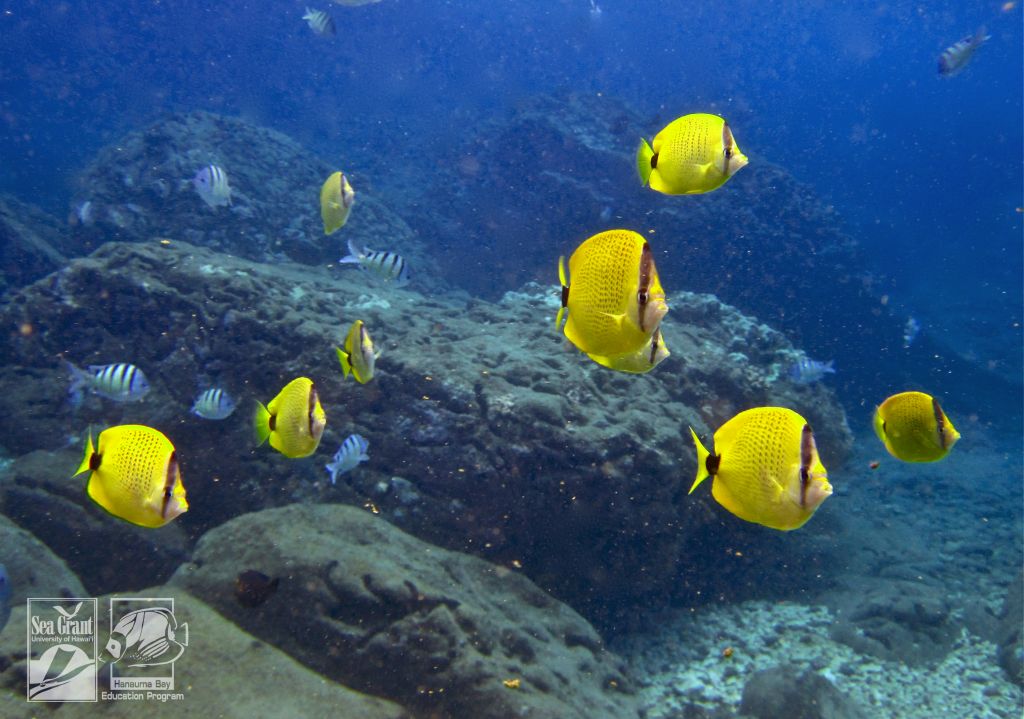
Lauwiliwili - Milletseed Butterflyfish
Chaetodontidae
Butterfly fish have narrow bodies so that they can fit through small spaces. They usually have a dark colored bar running through their eye area to obscure their eyes. Most species will also have a false eye-spot at their tail end to confuse predators. They are also characterized by having small, brush-like teeth. They mostly eat small invertebrates, plankton, coral polyps and algae. They have long-term, possibly permanent mates.
He‘eHe‘e Mauli - Day Octopus
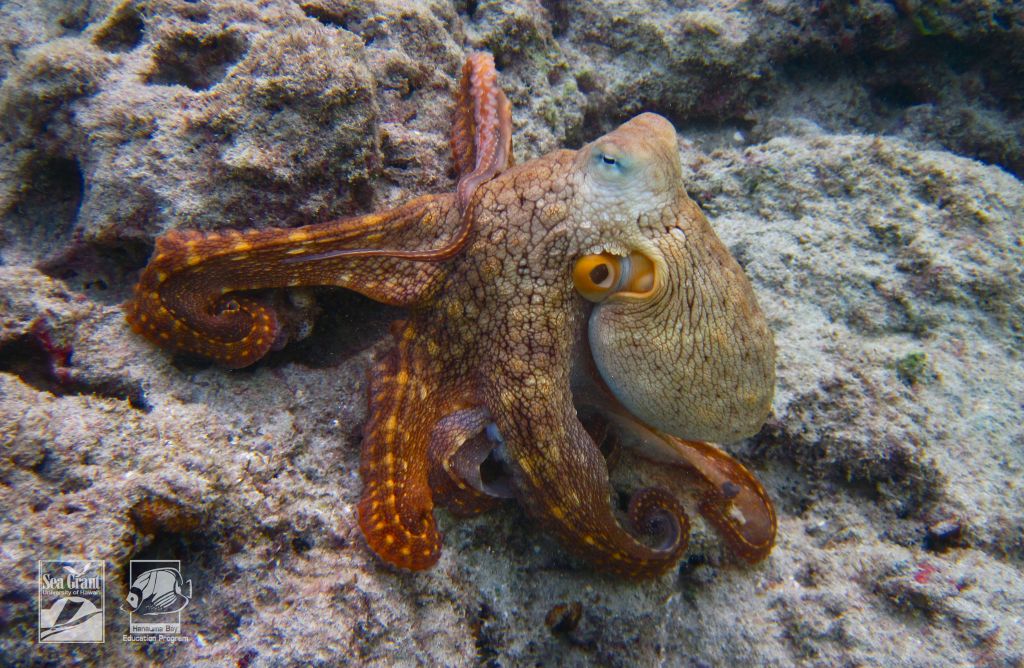
He‘e Mauli - Day Octopus
Octopus cyanea
This octopus is commonly seen in Hawai‘i. It is most active during the early morning and late afternoon. It can live in shallow water, but can also be found at depths of 150 ft. It is found in small openings in rocks or crawling over the reef looking for food.
The Day Octopus primarily eat crabs, but if the opportunity arises, they will also eat molluscs and small fish. They can inject poisonous saliva into their prey to kill or weaken the animal before consumption. They can also drill through tough shells by using a structure of tiny teeth called a radula. Their skin can change color and texture to match most any environment.
The Day Octopus is a solitary animal that spends about half its time foraging and half its time hiding in its lair. If startled, the octopus will dart away, changing colors several times to confuse predators. If harassed, it may shoot a powerful stream of water at its attacker. If that fails, it may pick up stones with its suckers, and use the stones as a type of shield. As a last resort, it will squirt ink. At night, it will cover the opening of its lair with stones for extra protection.
Humuhumu lei - Lei Triggerfish
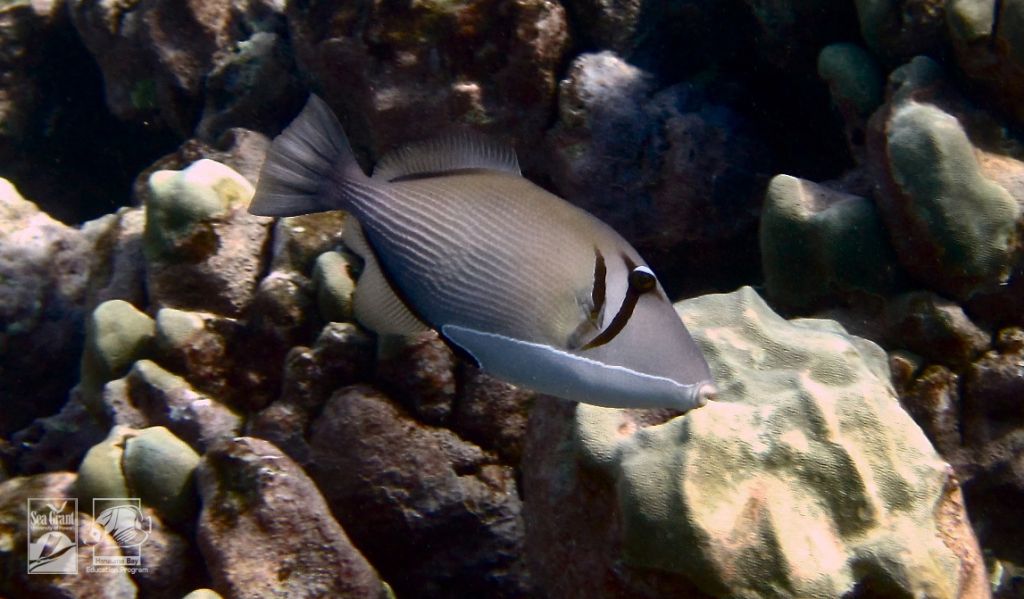
Humuhumu lei - Lei Triggerfish
Sufflamen bursa
Triggerfish are named from the thick, strong dorsal fins along their spines. The first of these fins can be erected and locked into place. If the triggerfish senses danger, it will swim into a crevice, raise its dorsal fin, and lock itself into the small space so that it can’t be moved. These fish also have tough skin, strong jaws, and their eyes can move independently. They feed on crustaceans, coral, mollusks, or whatever they can find that is small enough to eat. They can also swim backwards and forwards.
Specifically, the lei triggerfish has two curved bands running from the bottom of the pectoral fin to the bottom of the trigger on its back like two leis. These bands on each side can change colors from brown, yellow, or gray, possibly to signal the fish’s emotions. The lei triggerfish normally forage alone, but often will chase or circle each other in pairs in either territorial or sexual encounters. Females can often be seen showing an unusual behavior of guarding invisible eggs, they can be seen fluttering their pectoral fins with their head pointing down.
Moano - Manybar Goatfish
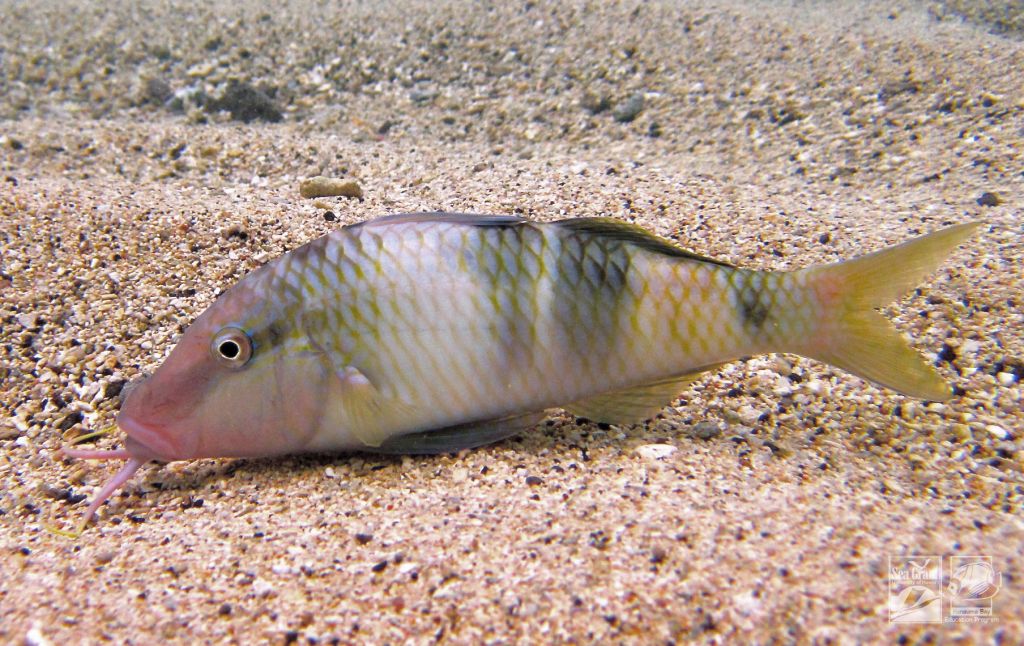
Moano - Manybar Goatfish
Parupeneus multifasciatus
The Hawaiian name for the Manybar goatfish means ‘pale red’. It was said that this fish became red from eating the red flowers from the ‘ohi‘a lehua. These fish are often a gray, red, or purple color, with two large vertical bars. These vertical bars, as well as other parts of the fish, can change color based on different activities the fish is involved in. When the goatfish is swimming, the bars often turn a bright white, and when they rest, the second bar can darken or disappear. Manybar Goatfish are most often seen in groups, feeding on small shrimp and crabs, however, occasionally some can be seen following a foraging moray eel to snatch any small critters it may flush out of the rocks.
‘O‘opu ōkala - Longspine Porcupinefish
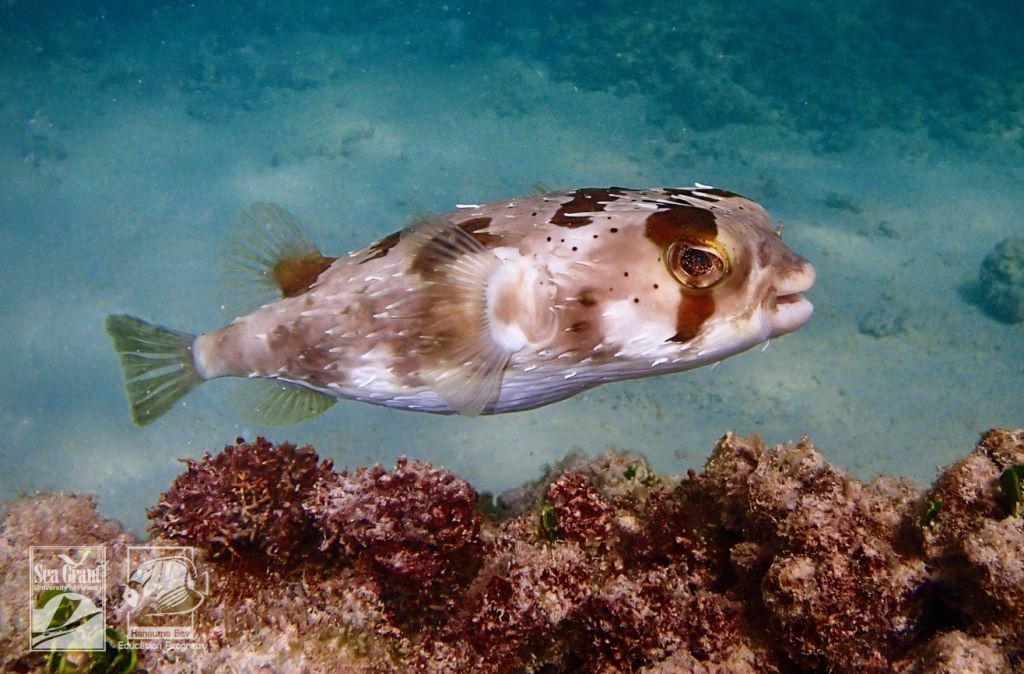
‘O‘opu ōkala - Longspine Porcupinefish
Diodon holocanthus Linnaeus
The general Hawaiian name for porcupine fish is: kōkala. Kōkala also means ‘the thorns on the edge of the lauhala leaf’.
Porcupinefish can inflate with water to make themselves too big to swallow. They are covered with sharp spines that lay flat against their body. These spines become erect as the fish begins to swell. This defensive adaptation can be deadly to marlins and sharks and other animals that try to prey on porcupinefish. Porcupinefish are also poisonous. Their organs and skin contain a toxin that causes paralysis and death. In Hawaii, it is illegal to serve porcupinefish in restaurants.
During the day, porcupinefish take rest in caves and under ledges. At night, they forage for invertebrates. They can blow jets of water across the sandy bottom to uncover prey. Out of the 19 different species of porcupine fish and burrfish worldwide, Hawai‘i has three species: the spotted burrfish, the giant porcupinefish, and the long spine porcupine fish.

